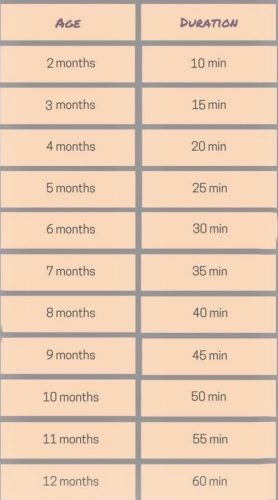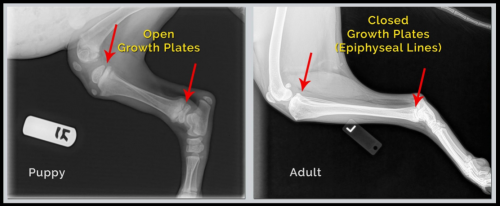Exercise, Growth, and Joints
Vizslas not only love exercise, they need exercise. We all look forward to taking our puppy for a walk, however it is important not to over-exercise your puppy.
In natural play, puppies will romp until they are tired and then stop to lie down for rest. When walking a puppy on a leash, they cannot stop when they normally would for rest. Even if they wanted to stop, they keep going to ‘keep up’ with their family.
Puppies’ bones and joints are still developing until they are at least 18-24 months old. Too much exercise or walking can severely damage their bone and joint structures irreversibly.
This should be taken seriously. Exercise that is not appropriate for the puppy’s age and development can cause significant and irreversible damage, setting the course of the puppy’s life as one of damaged joints and tissues, constant pain, hip and elbow reconstructions, costly vet bills, and compromised quality of life thereafter.
THE RULE is: No more than 5 minutes of exercise for every month of age
So that means, at 2 months old (8 weeks), your puppy only needs to exercise or walk for 10 minutes per day. At 3 months of age 15 minutes of exercise and so on.
If you walk your puppy too far too soon, your puppy may develop hip and elbow dysplasia as they get older. In many of these cases, it is often due to environmental factors such as over-exercise, running on hard or strenuous surfaces (such as concrete or sand), continual jumping or agility work.
Things to avoid with your puppy:
- No jumping in or out of car, especially larger cars. This is because all the weight is on the puppy’s front legs and elbow joints as he lands. Lift the dog or use a ramp.
- No throwing balls or frisbee great distances for your puppy to chase. The sudden stopping and over reaching with the front legs is dangerous.
- No agility, jumping or flyball before 2-3 years old
- Do not let other dogs knock or push the puppy over continually, includes body-slamming
- Avoid much stair climbing which can increase the risk of dysplasia
- No fast turns or roll-overs.
Good exercise:
- Swimming is great, since there is no weight-bearing impact on their joints. Remember, labradors love water!
- Walking on leash, for no longer than the recommended length of time for their age
- Self-directed play is an overriding rule for any puppy under 18 months old. The majority of exercise should be free play, exploring, and noodling around
- Hide and seek games are fantastic, as the dog can move at its own pace looking for its toy or treat or you. It’s great for their mental stimulation and learning
- Kibble trail is a learning game in which you hide kibble or small treats along a trail or route and the puppy sniffs them out, this way covering a good amount of ground in a natural way
- Playing with a well-matched gentle playmate is ideal. Size is a factor as large dogs, especially ones that like to play with paw whacks, can inadvertently injury a young puppy.
- Supervised play is critical. Be ready to throw down a handful of kibble to interrupt overly physical play, as body slams and crazy rolls are spiral fractures and torn ligaments waiting to happen…
- Toy-tug is ok to play, providing you hold the toy low and the puppy’s neck is in a straight line. Don’t pull on the toy, allow the puppy to tug against you. You need to teach the puppy a release command.
All these games are forms of exercise for puppies and are a great way to help your puppy learn useful lifelong skills and qualities.
Recommended Exercise Chart
Growth plates and bones: Development and injury
Growth Plates
Growth plates are soft areas that sit at the ends of the long bones in puppies and young dogs. They contain rapidly dividing cells that allow bones to grow longer until the end of puberty. Growth plates gradually thin as the hormonal changes approaching puberty signal the growth plates to close. In puppies, this closure normally completes between 18 to 24 months old in Vizslas.
Until the growth plates close, they’re soft and vulnerable to injury. After sexual maturity, the growth plates calcify and the rapid cell division ends. The growth plates become a stable, inactive part of the bone, now known as an epiphyseal line.
Dogs bones are held together with muscles, tendons and ligaments (soft tissue). In an adult dog, if a joint experiences a stress such as bending the wrong way or rotating too much, the bones will hold firm and soft tissue will be pulled, resulting in a sprain or tear. In a puppy, however, his soft tissues are stronger than his growth plates, so instead of a simple sprain, his growth plate is liable to be injured – the puppy’s own soft tissue can pull apart his growth plate.
Why this matters so much, is that unlike a sprain, injuries to the growth plate may not heal properly or not heal in time for the puppy to grow up straight and strong. Injury to a growth plate can result in a misshapen or shortened limb, which creates an incorrect angle to a joint resulting in yet more future injuries when he grows up, including dysplasia.


